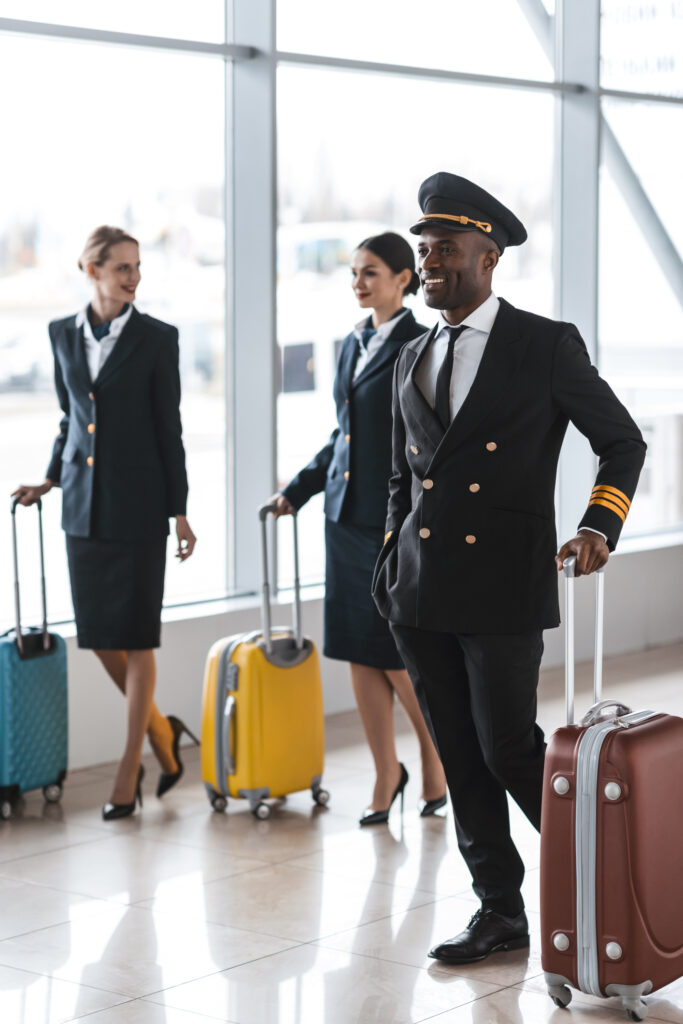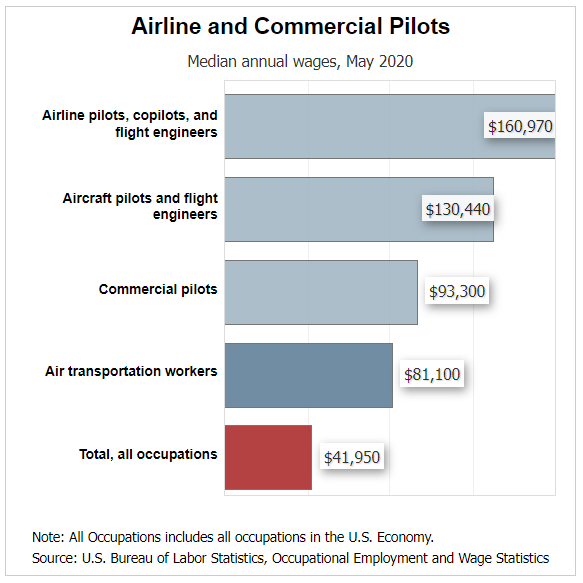A Career As A Pilot

Being a pilot is a dream career for many. Spending their workday in the sky overlooking a majestic mountain range, the tranquility of a deep blue ocean or the sun setting into a sea of clouds below. All this while earning a pretty good salary to boot. Since a career as a pilot is very different from most “9 to 5” jobs, let’s look at some aspects of the lifestyle.
An Airline Pilot's Life
Pilots often don’t have a fixed routine, as one would expect from a “9 to 5” job. Typically pilots have 9-15 days off a month. Many airline pilots typically average about 75 hours per month. How the days off are allocated over the month is a function of the airline operation needs and a pilot’s seniority in most cases. Most major airlines operate using a pilot hiring seniority system, where the longer you stay with the airline the higher your seniority. Each month, pilots get to “bid” on certain home bases, routes, or schedules. As such, pilots with higher seniority numbers tend to select the more preferred home bases, routes, and schedules allowing them to somewhat tailor their flying schedule to their personal preferences. With that said, newly hired pilots should expect to fly out of the lesser desired home base locations and schedules, at least for the first few years of service until their hiring seniority number ascends higher on the bidding scale.
While the “routine” may seem a little chaotic for newly hired airline pilots, it may not be so for some of the other pilot career options, such as –
- Flight Instructor
- Law Enforcement Pilot
- Agricultural Pilot
- Banner Towing Pilot
- Media and Patrol Pilot
- Air Photographer/cinematographer
- Air Tour Pilot
- Drone Pilot
These pilot careers tend to have a more consistent and structured routine, typically focused within one locale.

Flying as a pilot is something not many people get to do. It’s a very unique career with many benefits and with a little dedication, is in reach of just about anyone.
Growth and Opportunity
The aviation industry is growing and a pilot shortage is driving demand for new pilots every day. According to CAE, which just released its 2020-2029 CAE Pilot Demand Outlook, the civil aviation industry will need 260,000 new pilots over the next 10 years.
When starting your career, starting salaries can sometimes be a little challenging, but once you are established with a professional operator, like an airline, salaries can quickly exceed $100,000+ and you can get there in as quickly as 5 years or less.
According to the US Bureau of Labor Statistics,
- Commercial aircraft and airline pilot median salary in 2020 alone was $130,440
- The number of jobs in 2020 was 113,900
- Job Outlook, 2020-2030 growth rate is 13%, faster than the national average of 8% growth rate

After completing training and accumulating enough hours of experience, usually about 1,500 hours of flight time, pilots can apply to an airline and usually begin their careers as first officers and receive wage increases as they accumulate experience and seniority.
In addition to an airline pilot’s base salary, they can receive expense reimbursements known as “per diem” while on the clock and away from home plus friends and family benefits such as free or reduced-fare travel flights.
According to the US Bureau of Labor statics, “Federal regulations set the maximum work hours and minimum requirements for rest between flights for most pilots. Airline pilots fly an average of 75 hours per month, along with performing other duties, such as checking weather conditions and preparing flight plans. Pilots have variable work schedules that may include several days of work followed by some days off…..Commercial pilots also may have irregular schedules. Although most commercial pilots remain near their home overnight, they may still work nonstandard hours.” For more information, check out the US Bureau of Labor Statics “What Airline and Commercial Pilots Do”.
Other Pilot Options
While many pilots seek a career path with an Airline, there are many other career opportunities available. Here is more information on each of the many options to consider starting with a commercial airline pilot.
These pilots fly people all over the world. With more than 5,000 airlines worldwide, there is ample opportunity. Senior pilots can make in excess of $200,ooo a year fly for a major airline carrier.
Regional airline pilots tend to fly shorter distant domestic flights, with senior pilot salaries in excess of $100K. Many pilots start their career working for a regional airline to gain experience before moving onto a major airline. Others prefer regional airline schedules as they tend to be fewer overnight trips and keep a pilot closer to home.
Similar to both regional and major airline pilots with the exception that these are cargo flights and therefore no passengers. Cargo flights tend to be scheduled around more night flying than day flying, but still offer similar benefits and pay scales as the regional and major airlines.
If you would like to consider being paid to learn how to fly, then becoming a military pilot may be a good career option. Of course you would need to join a branch of the armed forces, but you could get to fly state of the art aircraft at speeds commonly not supported by civilian aircraft. Many airline pilots start their career as military pilots. In addition to having the government pay for your training, it’s a great way to build experience and accumulate flight hours.
These pilots, known as AG pilots or crop dusters, get paid to fly low and release chemicals over farmlands. They are invaluable contributors to the modern agriculture industry. If staying close to home and potentially becoming your own boss running a crop dusting business and still enjoy the pleasure of flying, crop dusting may be your calling.
These pilots work for the government in support of such agencies as the FAA, FBI, CIA, DEA, Homeland Security, State & Local Police, firefighters and more. In addition to government benefits, these types of pilot jobs offer high five/low six figure salaries and tend to support a more routine, closer to home, work schedule. In addition, these types of pilot jobs offer greater opportunities for helicopter pilots.
If you are looking to fly a private jet, like a Gulfstream, and cater to the lifestyles of the rich and famous, then flying a business jet may be your calling. These pilots tend to be more on demand travelers to just about any destination the aircraft can take you. Your passengers could be business people, actors and actresses, athletes, models and other well to do people. Based on the variety of options pursuing this career path as a pilot, pay and benefits can vary, but in many cases can be $100,000 plus.
Many professional pilots either teach on the side, workload permitting or teach when they retire. Others simply prefer to teach as a career. If you have a passion for teaching and helping others, you could opt to pursue a career as a flight instructor, with pay ranging from $30,000 – $100,000 plus depending on your level of commitment. For those with more entrepreneurial passions, developing a career as a flight instructor can be parlayed into a flight training business in and of itself.
While these are some of the more common pilot career paths, there are others to consider, each offering unique opportunities, including creating a full time or part time freelance business, such as –
- Ferry Pilot and Aircraft Salesmen Pilot
- Medical and Air Ambulance Pilot
- Banner Towing Pilot
- Media and Patrol Pilot
- Air Tour Pilot
- Airshow Stunt Pilot
- Contract Pilot
- Drone Pilot

